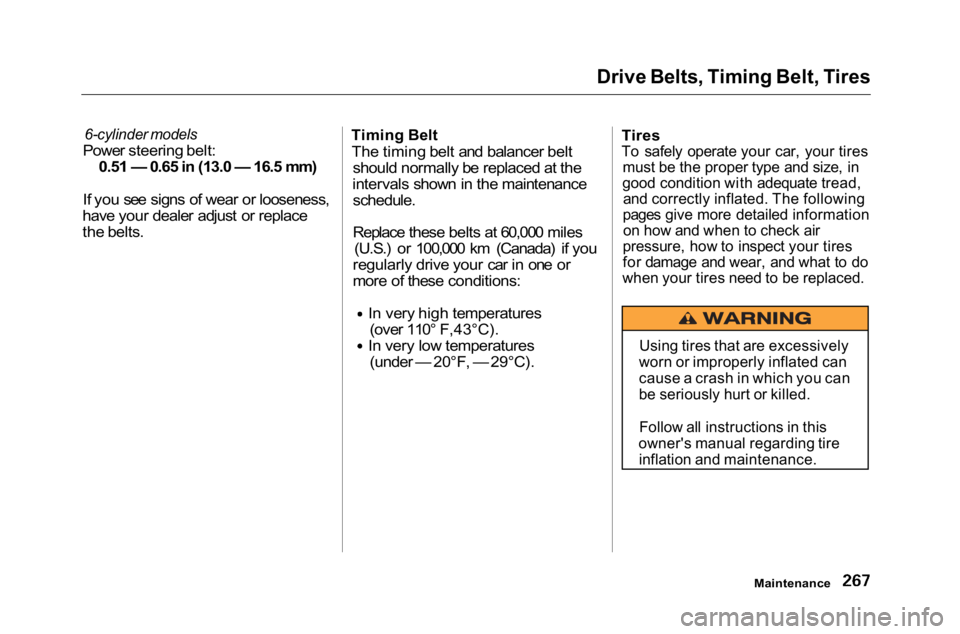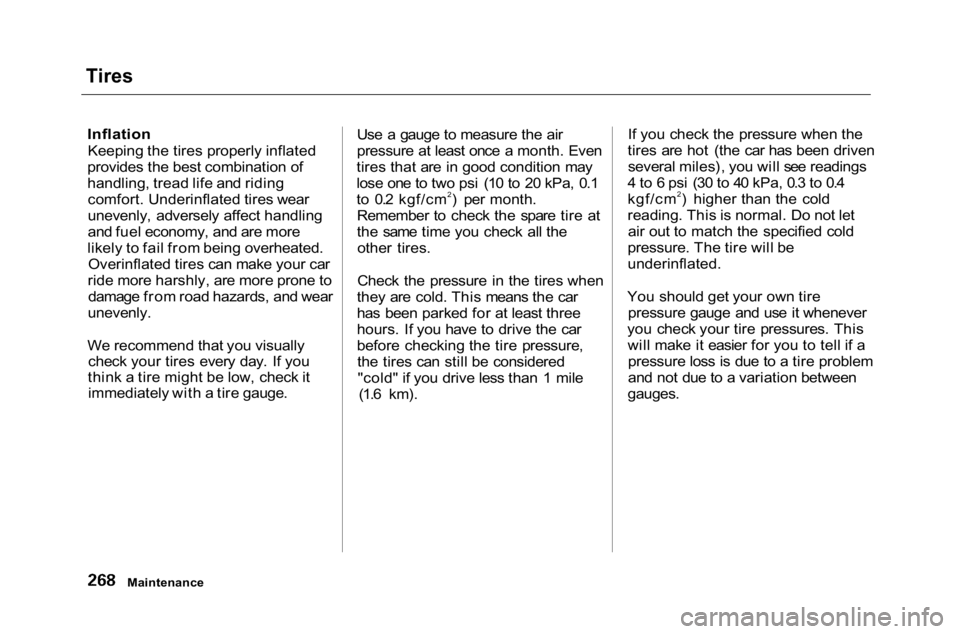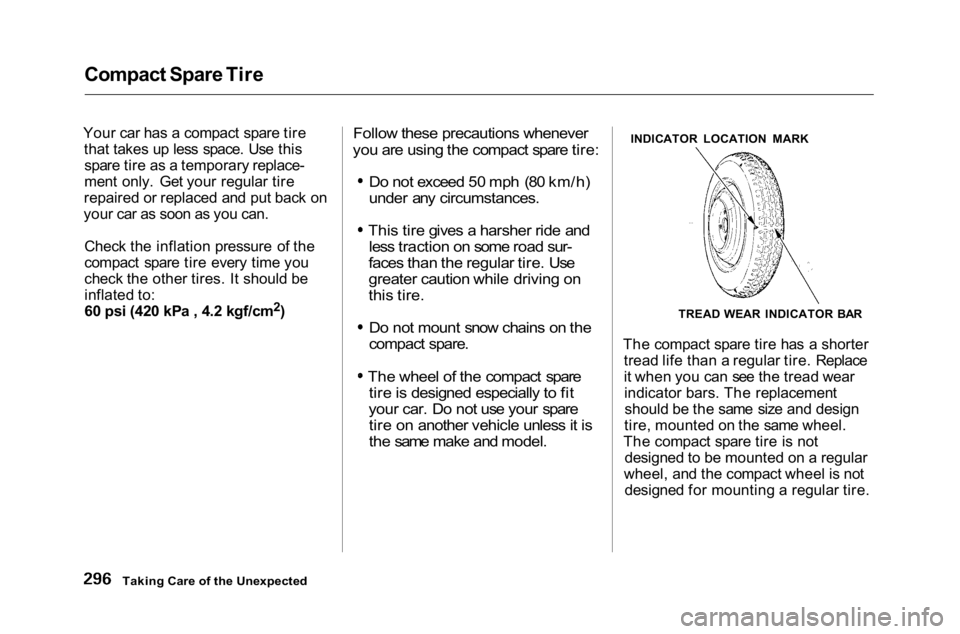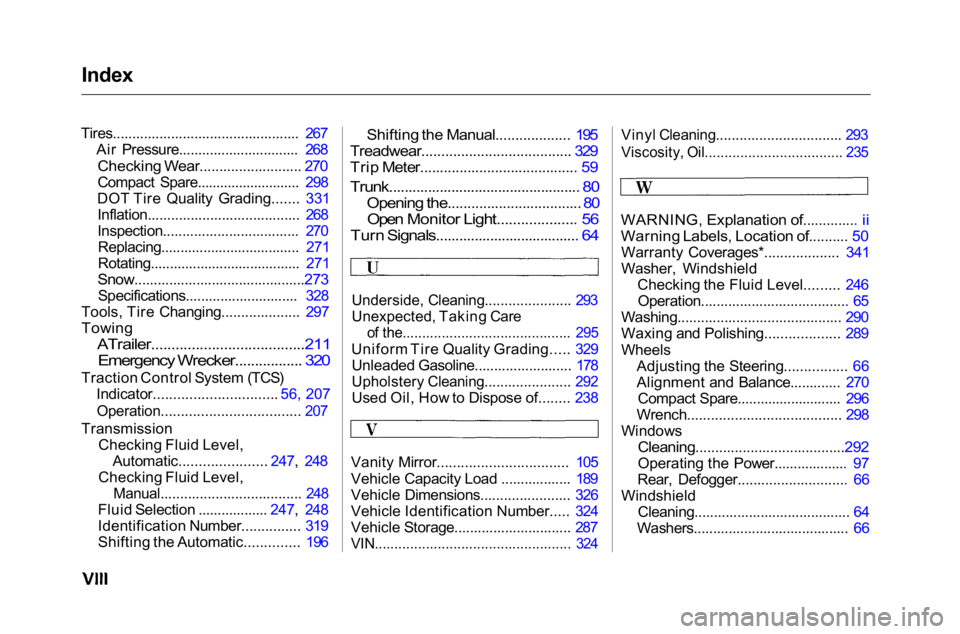inflation pressure HONDA ACCORD SEDAN 2001 Owner's Manual (in English)
[x] Cancel search | Manufacturer: HONDA, Model Year: 2001, Model line: ACCORD SEDAN, Model: HONDA ACCORD SEDAN 2001Pages: 372, PDF Size: 6.1 MB
Page 270 of 372

Drive Belts, Timing Belt, Tires
6-cylinder models
Power steering belt:
0.51 — 0.65 in (13.0 — 16.5 mm)
If you see signs of wear or looseness,
have your dealer adjust or replace
the belts.
Timing Belt
The timing belt and balancer belt
should normally be replaced at the
intervals shown in the maintenance
schedule.
Replace these belts at 60,000 miles
(U.S.) or 100,000 km (Canada) if you
regularly drive your car in one or
more of these conditions:
In very high temperatures
(over 110° F,43°C).
In very low temperatures
(under — 20°F, — 29°C).
Tires
To safely operate your car, your tires
must be the proper type and size, in
good condition with adequate tread,
and correctly inflated. The following
pages give more detailed information
on how and when to check air
pressure, how to inspect your tires
for damage and wear, and what to do
when your tires need to be replaced.
Maintenance
Using tires that are excessively
worn or improperly inflated can
cause a crash in which you can
be seriously hurt or killed.
Follow all instructions in this
owner's manual regarding tire
inflation and maintenance.
Page 271 of 372

Tires
Inflation
Keeping the tires properly inflated
provides the best combination of
handling, tread life and riding comfort. Underinflated tires wear
unevenly, adversely affect handling
and fuel economy, and are more
likely to fail from being overheated. Overinflated tires can make your car
ride more harshly, are more prone to damage from road hazards, and wear
unevenly.
We recommend that you visually check your tires every day. If you
think a tire might be low, check it immediately with a tire gauge. Use a gauge to measure the air
pressure at least once a month. Even
tires that are in good condition may
lose one to two psi (10 to 20 kPa, 0.1
to 0.2 kgf/cm2) per month. Remember to check the spare tire at
the same time you check all theother tires.
Check the pressure in the tires when
they are cold. This means the car
has been parked for at least three
hours. If you have to drive the car
before checking the tire pressure, the tires can still be considered"cold" if you drive less than 1 mile (1.6 km). If you check the pressure when the
tires are hot (the car has been driven several miles), you will see readings
4 to 6 psi (30 to 40 kPa, 0.3 to 0.4
kgf/cm2) higher than the cold
reading. This is normal. Do not let air out to match the specified cold
pressure. The tire will be
underinflated.
You should get your own tire pressure gauge and use it whenever
you check your tire pressures. This will make it easier for you to tell if apressure loss is due to a tire problem
and not due to a variation between
gauges.
Maintenance
Page 299 of 372

Compact Spare Tire
Your car has a compact spare tire that takes up less space. Use thisspare tire as a temporary replace-
ment only. Get your regular tire
repaired or replaced and put back on
your car as soon as you can.
Check the inflation pressure of the
compact spare tire every time you
check the other tires. It should be
inflated to:
60 psi (420 kPa , 4.2 kgf/cm 2
)
Follow these precautions whenever
you are using the compact spare tire:
Do not exceed 50 mph (80 km/h)
under any circumstances.
This tire gives a harsher ride and less traction on some road sur-
faces than the regular tire. Use
greater caution while driving on
this tire.
Do not mount snow chains on the
compact spare.
The wheel of the compact spare tire is designed especially to fit
your car. Do not use your spare tire on another vehicle unless it is
the same make and model.
INDICATOR LOCATION MARK
The compact spare tire has a shorter tread life than a regular tire. Replace
it when you can see the tread wearindicator bars. The replacementshould be the same size and design
tire, mounted on the same wheel.
The compact spare tire is not designed to be mounted on a regular
wheel, and the compact wheel is not designed for mounting a regular tire.
Taking Care of the Unexpected
TREAD WEAR INDICATOR BAR
Page 357 of 372

Index
Tires................................................ 267 Air Pressure............................... 268
Checking Wear.......................... 270
Compact Spare........................... 298
DOT Tire Quality Grading....... 331 Inflation....................................... 268
Inspection................................... 270Replacing.................................... 271
Rotating....................................... 271
Snow............................................273
Specifications............................. 328
Tools, Tire Changing.................... 297
Towing
ATrailer......................................211
Emergency Wrecker................. 320
Traction Control System (TCS) Indicator...............................
56, 207
Operation................................... 207
Transmission Checking Fluid Level,Automatic...................... 247, 248
Checking Fluid Level,
Manual.................................... 248
Fluid Selection .................. 247, 248
Identification Number............... 319
Shifting the Automatic.............. 196
Shifting the Manual................... 195
Treadwear...................................... 329
Trip Meter........................................ 59
Trunk................................................. 80
Opening the..................................
80
Open Monitor Light.................... 56
Turn Signals..................................... 64
Underside, Cleaning...................... 293
Unexpected, Taking Care
of the........................................... 295
Uniform Tire Quality Grading..... 329
Unleaded Gasoline......................... 178
Upholstery Cleaning...................... 292
Used Oil, How to Dispose of........ 238
Vanity Mirror................................. 105
Vehicle Capacity Load .................. 189
Vehicle Dimensions....................... 326
Vehicle Identification Number..... 324
Vehicle Storage.............................. 287
VIN.................................................. 324
Vinyl Cleaning................................ 293
Viscosity, Oil................................... 235
WARNING, Explanation of.............. ii
Warning Labels, Location of.......... 50
Warranty Coverages*................... 341
Washer, Windshield Checking the Fluid Level......... 246Operation...................................... 65
Washing.......................................... 290
Waxing and Polishing................... 289
Wheels Adjusting the Steering................ 66
Alignment and Balance............. 270Compact Spare........................... 296
Wrench....................................... 298
Windows
Cleaning......................................292
Operating the Power................... 97
Rear, Defogger............................ 66
Windshield Cleaning........................................ 64
Washers........................................ 66